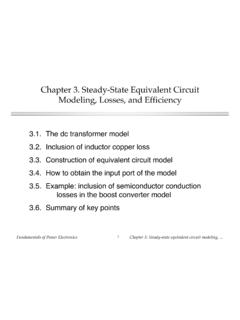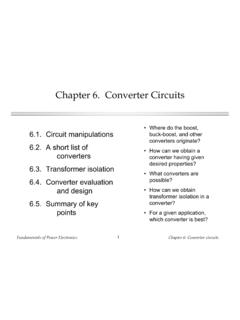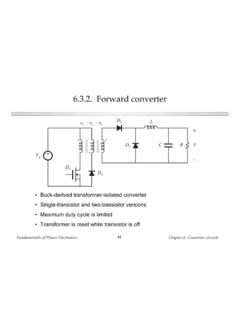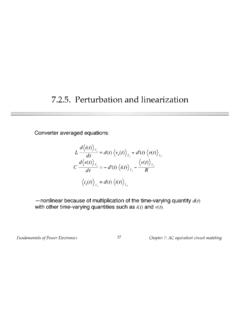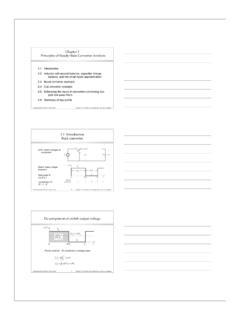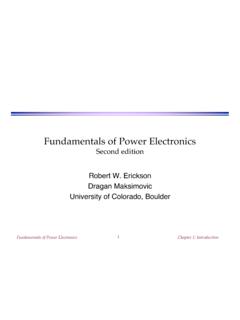Transcription of Fundamentals of Power Electronics - diegm.uniud.it
1 Fundamentals of Power ElectronicsChapter 1: Introduction1 Fundamentals of Power ElectronicsSecond editionRobert W. EricksonDragan MaksimovicUniversity of Colorado, BoulderFundamentals of Power ElectronicsChapter 1: Introduction2 Chapter 1: Introduction to Power Some applications of Power Elements of Power electronicsSummary of the courseFundamentals of Power ElectronicsChapter 1: Introduction to Power ProcessingDc-dc conversion:Change and control voltage magnitudeAc-dc rectification:Possibly control dc voltage, ac currentDc-ac inversion:Produce sinusoid of controllablemagnitude and frequencyAc-ac cycloconversion:Change and control voltage magnitudeand frequencySwitchingconverterPowerinputPow eroutputControlinputFundamentals of Power ElectronicsChapter 1: Introduction4 Control is invariably requiredSwitchingconverterPowerinputPowe routputControlinputControllerreferencefe edbackfeedforwardFundamentals of Power ElectronicsChapter 1.
2 Introduction5 High efficiency is essentialHigh efficiency leads to lowpower loss within converterSmall size and reliable operationis then feasibleEfficiency is a good measure ofconverter / Pout =PoutPinPloss=Pin Pout=Pout1 1 Fundamentals of Power ElectronicsChapter 1: Introduction6A high-efficiency converterA goal of current converter technology is to construct converters of smallsize and weight, which process substantial Power at high efficiencyConverterPinPoutFundamentals of Power ElectronicsChapter 1: Introduction7 Devices available to the circuit designerDTsTsResistorsCapacitorsMagnetic sSemiconductor devicesLinear-mode+ Switched-modeFundamentals of Power ElectronicsChapter 1: Introduction8 Devices available to the circuit designerSignal processing: avoid magneticsDTsTsResistorsCapacitorsMagneti csSemiconductor devicesLinear-mode+ Switched-modeFundamentals of Power ElectronicsChapter 1: Introduction9 Devices available to the circuit designerPower processing: avoid lossy elementsDTsTsResistorsCapacitorsMagnetic sSemiconductor devicesLinear-mode+ Switched-modeFundamentals of Power ElectronicsChapter 1: Introduction10 Power loss in an ideal switchSwitch closed:v(t) = 0 Switch open:i(t) = 0In either event:p(t) = v(t) i(t) = 0 Ideal switch consumes zero Power +v(t) i(t) Fundamentals of Power ElectronicsChapter 1: Introduction11A simple dc-dc converter exampleInput source: 100 VOutput load: 50V, 10A, 500 WHow can this converter be realized?
3 + R5 +V50V Vg100VI10 ADc-dcconverterFundamentals of Power ElectronicsChapter 1: Introduction12 Dissipative realizationResistive voltage divider+ R5 +V50V Vg100VI10A+ 50V Ploss = 500 WPout = 500 WPin = 1000 WFundamentals of Power ElectronicsChapter 1: Introduction13 Dissipative realizationSeries pass regulator: transistor operates inactive region+ R5 +V50V Vg100VI10A+ 50V Ploss 500 WPout = 500 WPin 1000W+ linear amplifierand base driverVrefFundamentals of Power ElectronicsChapter 1: Introduction14 Use of a SPDT switch+ R+v(t)50 V 12+vs(t) Vg100 VI10 Avs(t)VgDTs(1 D) Ts0tswitchposition:121Vs = DVgFundamentals of Power ElectronicsChapter 1: Introduction15 The switch changes the dc voltage levelD = switch duty cycle0 D 1Ts = switching periodfs = switching frequency = 1 / TsVs=1 Tsvs(t)dt0Ts=DVgDC component of vs(t) = average value:vs(t)VgDTs(1 D) Ts0tswitchposition:121Vs = DVgFundamentals of Power ElectronicsChapter 1: Introduction16 Addition of low pass filterAddition of (ideally lossless) L-C low-pass filter, forremoval of switching harmonics: Choose filter cutoff frequency f0 much smaller than switchingfrequency fs This circuit is known as the buck converter + R+v(t) 12+vs(t) Vg100 Vi(t)LCPloss smallPout = 500 WPin 500 WFundamentals of Power ElectronicsChapter 1: Introduction17 Addition of control systemfor regulation of output voltage (t)TsdTst+ +v vgSwitching converterPowerinputLoad +CompensatorvrefReferenceinputHvPulse-wi dthmodulatorvcTransistorgate driver Gc(s)H(s)veErrorsignalSensorgainiFundame ntals of Power ElectronicsChapter 1: Introduction18 The boost converter+ LCR+V of Power ElectronicsChapter 1.
4 Introduction19A single-phase inverter12+ load+ v(t) 21 Vgvs(t)+ tvs(t) H-bridge Modulate switchduty cycles toobtain sinusoidallow-frequencycomponentFundamen tals of Power ElectronicsChapter 1: Several applications of Power electronicsPower levels encountered in high-efficiency converters less than 1 W in battery-operated portable equipment tens, hundreds, or thousands of watts in Power supplies forcomputers or office equipment kW to MW in variable-speed motor drives 1000 MW in rectifiers and inverters for utility dc transmissionlinesFundamentals of Power ElectronicsChapter 1: Introduction21A laptop computer Power supply systemvac(t)iac(t)ChargerPWMR ectifierLithiumbatteryac line input85 265 VrmsInverterBuckconverterBoostconverterD isplaybacklightingMicroprocessorPowerman agementDiskdriveFundamentals of Power ElectronicsChapter 1: Introduction22 Power system of an earth-orbiting spacecraftSolararray+vbus BatteriesBatterycharge/dischargecontroll ersDc-dcconverterPayloadDc-dcconverterPa yloadDissipativeshunt regulatorFundamentals of Power ElectronicsChapter 1: Introduction23An electric vehicle Power and drive system3 ac line50/60 HzBatterychargerbattery+vb Variable-frequencyVariable-voltage acInverterac machineInverterInverterac machineDC-DCconverter PsystemcontrollerVehicleelectronicsLow-v oltagedc buscontrol busac machineac machineInverter
![PF-014893 - IECON'06 - Petrella.ppt [modalità compatibilità]](/cache/preview/a/c/1/a/1/5/a/f/thumb-ac1a15af4094fea0a1d8c1297e1d20f6.jpg)

